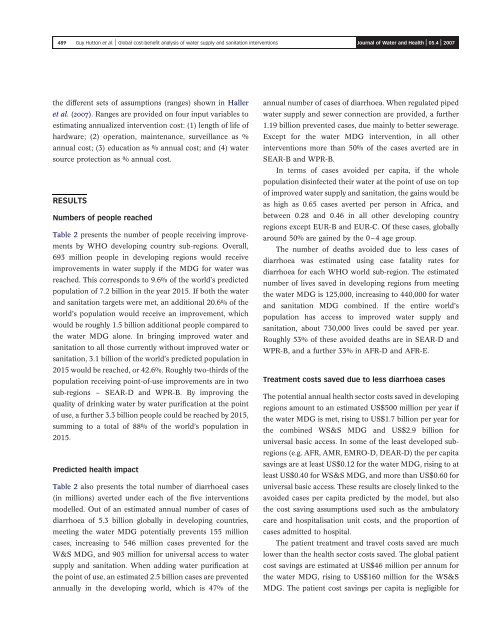Global cost-benefit analysis of water supply and sanitation ... - SuSanA
Global cost-benefit analysis of water supply and sanitation ... - SuSanA
Global cost-benefit analysis of water supply and sanitation ... - SuSanA
You also want an ePaper? Increase the reach of your titles
YUMPU automatically turns print PDFs into web optimized ePapers that Google loves.
489 Guy Hutton et al. | <strong>Global</strong> <strong>cost</strong>-<strong>benefit</strong> <strong>analysis</strong> <strong>of</strong> <strong>water</strong> <strong>supply</strong> <strong>and</strong> <strong>sanitation</strong> interventions Journal <strong>of</strong> Water <strong>and</strong> Health | 05.4 | 2007<br />
the different sets <strong>of</strong> assumptions (ranges) shown in Haller<br />
et al. (2007). Ranges are provided on four input variables to<br />
estimating annualized intervention <strong>cost</strong>: (1) length <strong>of</strong> life <strong>of</strong><br />
hardware; (2) operation, maintenance, surveillance as %<br />
annual <strong>cost</strong>; (3) education as % annual <strong>cost</strong>; <strong>and</strong> (4) <strong>water</strong><br />
source protection as % annual <strong>cost</strong>.<br />
RESULTS<br />
Numbers <strong>of</strong> people reached<br />
Table 2 presents the number <strong>of</strong> people receiving improvements<br />
by WHO developing country sub-regions. Overall,<br />
693 million people in developing regions would receive<br />
improvements in <strong>water</strong> <strong>supply</strong> if the MDG for <strong>water</strong> was<br />
reached. This corresponds to 9.6% <strong>of</strong> the world’s predicted<br />
population <strong>of</strong> 7.2 billion in the year 2015. If both the <strong>water</strong><br />
<strong>and</strong> <strong>sanitation</strong> targets were met, an additional 20.6% <strong>of</strong> the<br />
world’s population would receive an improvement, which<br />
would be roughly 1.5 billion additional people compared to<br />
the <strong>water</strong> MDG alone. In bringing improved <strong>water</strong> <strong>and</strong><br />
<strong>sanitation</strong> to all those currently without improved <strong>water</strong> or<br />
<strong>sanitation</strong>, 3.1 billion <strong>of</strong> the world’s predicted population in<br />
2015 would be reached, or 42.6%. Roughly two-thirds <strong>of</strong> the<br />
population receiving point-<strong>of</strong>-use improvements are in two<br />
sub-regions – SEAR-D <strong>and</strong> WPR-B. By improving the<br />
quality <strong>of</strong> drinking <strong>water</strong> by <strong>water</strong> purification at the point<br />
<strong>of</strong> use, a further 3.3 billion people could be reached by 2015,<br />
summing to a total <strong>of</strong> 88% <strong>of</strong> the world’s population in<br />
2015.<br />
Predicted health impact<br />
Table 2 also presents the total number <strong>of</strong> diarrhoeal cases<br />
(in millions) averted under each <strong>of</strong> the five interventions<br />
modelled. Out <strong>of</strong> an estimated annual number <strong>of</strong> cases <strong>of</strong><br />
diarrhoea <strong>of</strong> 5.3 billion globally in developing countries,<br />
meeting the <strong>water</strong> MDG potentially prevents 155 million<br />
cases, increasing to 546 million cases prevented for the<br />
W&S MDG, <strong>and</strong> 903 million for universal access to <strong>water</strong><br />
<strong>supply</strong> <strong>and</strong> <strong>sanitation</strong>. When adding <strong>water</strong> purification at<br />
the point <strong>of</strong> use, an estimated 2.5 billion cases are prevented<br />
annually in the developing world, which is 47% <strong>of</strong> the<br />
annual number <strong>of</strong> cases <strong>of</strong> diarrhoea. When regulated piped<br />
<strong>water</strong> <strong>supply</strong> <strong>and</strong> sewer connection are provided, a further<br />
1.19 billion prevented cases, due mainly to better sewerage.<br />
Except for the <strong>water</strong> MDG intervention, in all other<br />
interventions more than 50% <strong>of</strong> the cases averted are in<br />
SEAR-B <strong>and</strong> WPR-B.<br />
In terms <strong>of</strong> cases avoided per capita, if the whole<br />
population disinfected their <strong>water</strong> at the point <strong>of</strong> use on top<br />
<strong>of</strong> improved <strong>water</strong> <strong>supply</strong> <strong>and</strong> <strong>sanitation</strong>, the gains would be<br />
as high as 0.65 cases averted per person in Africa, <strong>and</strong><br />
between 0.28 <strong>and</strong> 0.46 in all other developing country<br />
regions except EUR-B <strong>and</strong> EUR-C. Of these cases, globally<br />
around 50% are gained by the 0–4 age group.<br />
The number <strong>of</strong> deaths avoided due to less cases <strong>of</strong><br />
diarrhoea was estimated using case fatality rates for<br />
diarrhoea for each WHO world sub-region. The estimated<br />
number <strong>of</strong> lives saved in developing regions from meeting<br />
the <strong>water</strong> MDG is 125,000, increasing to 440,000 for <strong>water</strong><br />
<strong>and</strong> <strong>sanitation</strong> MDG combined. If the entire world’s<br />
population has access to improved <strong>water</strong> <strong>supply</strong> <strong>and</strong><br />
<strong>sanitation</strong>, about 730,000 lives could be saved per year.<br />
Roughly 53% <strong>of</strong> these avoided deaths are in SEAR-D <strong>and</strong><br />
WPR-B, <strong>and</strong> a further 33% in AFR-D <strong>and</strong> AFR-E.<br />
Treatment <strong>cost</strong>s saved due to less diarrhoea cases<br />
The potential annual health sector <strong>cost</strong>s saved in developing<br />
regions amount to an estimated US$500 million per year if<br />
the <strong>water</strong> MDG is met, rising to US$1.7 billion per year for<br />
the combined WS&S MDG <strong>and</strong> US$2.9 billion for<br />
universal basic access. In some <strong>of</strong> the least developed subregions<br />
(e.g. AFR, AMR, EMRO-D, DEAR-D) the per capita<br />
savings are at least US$0.12 for the <strong>water</strong> MDG, rising to at<br />
least US$0.40 for WS&S MDG, <strong>and</strong> more than US$0.60 for<br />
universal basic access. These results are closely linked to the<br />
avoided cases per capita predicted by the model, but also<br />
the <strong>cost</strong> saving assumptions used such as the ambulatory<br />
care <strong>and</strong> hospitalisation unit <strong>cost</strong>s, <strong>and</strong> the proportion <strong>of</strong><br />
cases admitted to hospital.<br />
The patient treatment <strong>and</strong> travel <strong>cost</strong>s saved are much<br />
lower than the health sector <strong>cost</strong>s saved. The global patient<br />
<strong>cost</strong> savings are estimated at US$46 million per annum for<br />
the <strong>water</strong> MDG, rising to US$160 million for the WS&S<br />
MDG. The patient <strong>cost</strong> savings per capita is negligible for
















